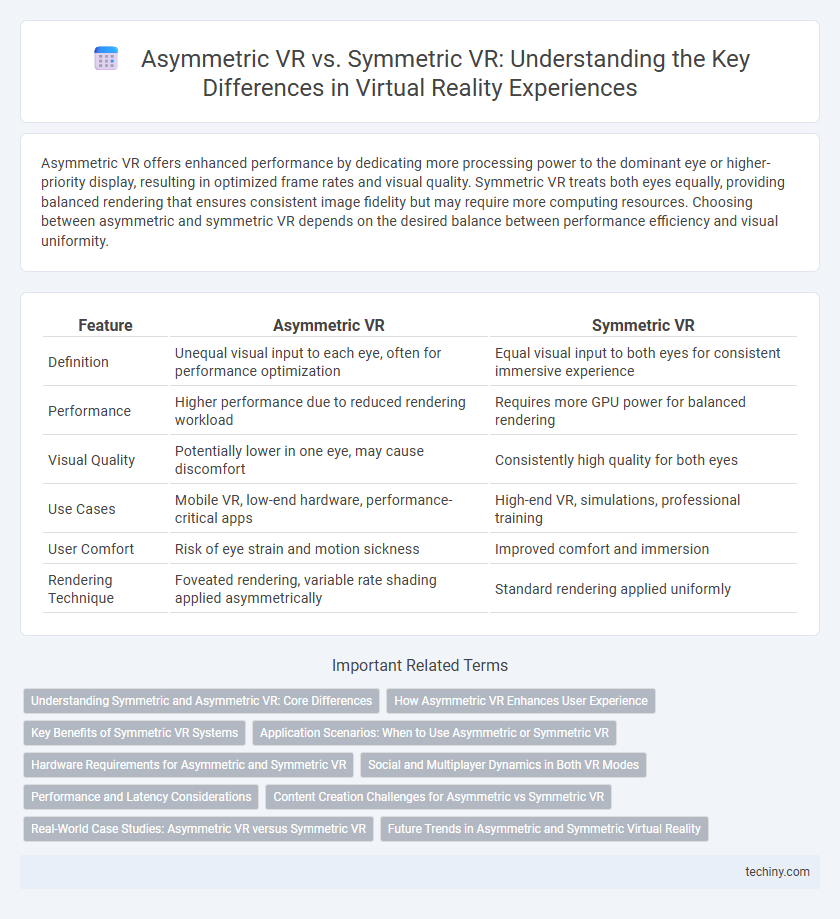Asymmetric VR offers enhanced performance by dedicating more processing power to the dominant eye or higher-priority display, resulting in optimized frame rates and visual quality. Symmetric VR treats both eyes equally, providing balanced rendering that ensures consistent image fidelity but may require more computing resources. Choosing between asymmetric and symmetric VR depends on the desired balance between performance efficiency and visual uniformity.
Table of Comparison
| Feature | Asymmetric VR | Symmetric VR |
|---|---|---|
| Definition | Unequal visual input to each eye, often for performance optimization | Equal visual input to both eyes for consistent immersive experience |
| Performance | Higher performance due to reduced rendering workload | Requires more GPU power for balanced rendering |
| Visual Quality | Potentially lower in one eye, may cause discomfort | Consistently high quality for both eyes |
| Use Cases | Mobile VR, low-end hardware, performance-critical apps | High-end VR, simulations, professional training |
| User Comfort | Risk of eye strain and motion sickness | Improved comfort and immersion |
| Rendering Technique | Foveated rendering, variable rate shading applied asymmetrically | Standard rendering applied uniformly |
Understanding Symmetric and Asymmetric VR: Core Differences
Asymmetric VR involves distinct user roles with different experiences or control levels, often seen in multiplayer settings where one player may have a unique perspective or abilities compared to others. Symmetric VR provides identical experiences and interaction capabilities to all users, promoting uniform immersion and collaboration in virtual environments. Understanding these core differences is crucial for designing VR applications that cater to specific social dynamics and user engagement strategies.
How Asymmetric VR Enhances User Experience
Asymmetric VR enhances user experience by allocating different processing loads to the headset and external devices, optimizing performance and reducing latency for more immersive interactions. This approach enables higher-quality visuals on one eye through foveated rendering and more precise tracking without overwhelming the system's resources. Asymmetric VR systems provide smoother frame rates and improved responsiveness, leading to greater comfort and a heightened sense of presence in virtual environments.
Key Benefits of Symmetric VR Systems
Symmetric VR systems offer consistent experience by delivering identical visual, auditory, and haptic feedback to all users, enhancing collaboration and immersion in multi-user environments. These systems reduce latency and synchronization issues compared to asymmetric VR, ensuring seamless shared interactions. By maintaining uniform data streams and hardware setups, symmetric VR supports scalable training, gaming, and remote teamwork applications more effectively.
Application Scenarios: When to Use Asymmetric or Symmetric VR
Asymmetric VR is ideal for training and collaborative environments where participants have distinct roles and access to different information, such as medical simulations or remote assistance. Symmetric VR suits gaming and social interactions where all users share the same virtual environment and have equal capabilities, fostering immersion and equal participation. Choosing between asymmetric and symmetric VR depends on the need for role differentiation versus uniform interaction among users.
Hardware Requirements for Asymmetric and Symmetric VR
Asymmetric VR requires disparate hardware setups for each user, often combining a high-performance headset with a lower-spec device to balance cost and performance, optimizing resource allocation. Symmetric VR demands identical hardware configurations across all users, ensuring uniform processing power, rendering quality, and input capabilities for a consistent immersive experience. The hardware variations directly influence development complexity and scalability, with asymmetric setups favoring flexibility and symmetric setups guaranteeing standardized interaction fidelity.
Social and Multiplayer Dynamics in Both VR Modes
Asymmetric VR allows users with different hardware to interact in shared virtual spaces, enhancing accessibility and social diversity by enabling varied user experiences within the same environment. Symmetric VR provides equal capabilities and immersive presence for all participants, fostering balanced multiplayer dynamics and competitive fairness. Both modes impact social interaction patterns differently, with asymmetric VR promoting inclusivity and mixed-experience collaboration, while symmetric VR optimizes uniform engagement and synchronized group activities.
Performance and Latency Considerations
Asymmetric VR distributes rendering workloads unevenly between the two eyes, optimizing performance by allocating higher resolution or frame rates to the dominant eye, reducing latency and resource consumption. Symmetric VR provides equal rendering quality and processing to both eyes, ensuring visual consistency but potentially increasing latency due to balanced computational demands. Prioritizing asymmetric VR strategies can enhance real-time responsiveness and frame rates, critical for immersive experiences requiring minimal motion sickness.
Content Creation Challenges for Asymmetric vs Symmetric VR
Content creation in asymmetric VR faces challenges in balancing vastly different user devices, requiring adaptive design to ensure seamless interaction across high-end and low-end hardware. Symmetric VR allows for uniform content development targeted at similar device capabilities but limits customization for diverse user experiences. Asymmetric VR demands complex optimization techniques and scalable assets to address performance disparities and maintain immersion quality.
Real-World Case Studies: Asymmetric VR versus Symmetric VR
Real-world case studies reveal that asymmetric VR setups, where each eye receives different visual input, enhance depth perception and spatial awareness in industrial training simulations compared to symmetric VR, which presents identical images to both eyes. Research from automotive design labs demonstrates asymmetric VR's superiority in accurately rendering complex 3D models, reducing design errors by 25%. Symmetric VR remains prevalent in entertainment due to simpler implementation and cost efficiency, but asymmetric VR's application in professional fields highlights its advantage in precision and user immersion.
Future Trends in Asymmetric and Symmetric Virtual Reality
Asymmetric VR leverages differing device capabilities between users to optimize resource allocation, while Symmetric VR ensures equal hardware and experience across participants. Future trends in Asymmetric VR emphasize scalable and adaptive rendering techniques powered by AI to enhance immersion for diverse user setups. Symmetric VR developments focus on uniform ultra-high fidelity graphics and synchronized real-time interactions using 5G and edge computing technologies.
Asymmetric VR vs Symmetric VR Infographic

 techiny.com
techiny.com